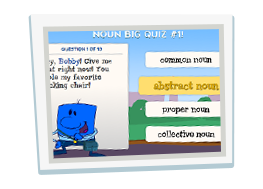Grammaropolis is an online, subscription-access program for learning about the eight parts of speech. (It’s also available as an app for iPad, iPhone, or iPod Touch as well as for Android devices.)
Grammaropolis should be appropriate for children in about second or third grade up through about sixth grade. Older students who haven’t yet mastered the parts of speech can also use it; it’s not at all babyish. The parts of speech are presented with more complexity than we usually find for the primary grades. For example, when children learn about nouns, they learn about various types of nouns: common, proper, abstract, concrete, collective, and compound. Students read from the screens, so their reading skills need to be at least second- or third-grade level.
You can register up to five students in a single subscription. Everyone uses the same login. However, student progress is tracked individually as they complete quizzes. If you have more than one student enrolled in the program, students need to select their own name before they take a quiz. Results will be confused if they fail to do this. Screens prompt them to do so, so it shouldn’t be a problem.
Grammaropolis’s animated cartoon characters, catchy music, and fast-paced lessons are likely to hold students’ attention. The animation is a little more fluid than what I’ve seen in many educational programs. The same cartoon characters are featured throughout the program, whether in lesson material, videos, songs, or storybooks.
Each of the eight parts of speech has its own “map” with a progression of activities for a student to complete. Each map begins with a number of screens presenting definitions and examples. This is the basic teaching material, although it is reinforced and expanded upon as students work through the rest of the map. Next on the map is a catchy song that illustrates the definitions with drama, cartoons, and graphics—essentially a music video that presents rules and examples in a way that students are likely to remember. The songs are really creative and well-performed with some dialogue intermixed with the music. The songs are quite entertaining! (The Grammaropolis album is available separately at the iTunes store.)
A number of activities besides the song are also included in each map. These either emphasize the basic definition or work on sub-points. For example, students learn the definition of a noun and the various types of nouns. Then sub-lessons focus on particular types of nouns. Some activities include a few brief (less than 30 seconds), animated cartoon segments. An online storybook within each map reinforces concepts with a cute storyline.
The various activities are usually followed by a three-question, multiple-choice quiz. There are also less frequent “big quizzes” with ten multiple-choice questions. All quizzes show whether the answer is correct or incorrect immediately after each question is answered. There are no second guesses at that point. However, students can go through a map again and retake quizzes, replacing their previous scores with better scores. Some questions differ the second time around, but not much. Since quiz questions had to be written for a wide age span of students, they are often too easy for older students.
Grammaropolis does an excellent job of teaching the basics for the parts of speech, and it is limited to only that topic. It does not teach all of the complexities of syntax such as nouns used as subjects, direct objects, and objects of prepositions. While it is limited in scope, it does a very good job with what it covers.
Students should be applying what they learn in Grammaropolis in writing assignments within other programs. So if Grammaropolis quizzes are too easy, students can be held accountable for their mastery of grammar at an appropriate level within their other assignments.
The dashboard for your account provides detailed reporting showing which activities have been completed on each of the eight maps by each student as well as quiz scores.
I was able to complete an entire map in about an hour, so I expect some students can whip through these fairly quickly too. The noun map is available for free to try it out. If you have older students, subscribing for just a few months might be sufficient. With younger students, you might want to subscribe for at least a year. And if you’ve got a family with a wide age range, the forever subscription might be the best choice.
By the way, if you’ve got older students in middle school or junior high, don’t miss the “lesson plan” for students to write a children’s book from the point of view of a single part of speech. You can find it by going to the FAQ page and clicking on the link under the first question, “Did Grammaropolis really come from classroom lesson plans?”
It is easy to access your account and quickly get to the desired map. It’s also easy to pick up where you left off on a map by simply clicking on the next step—as long as you either remember which step was last completed or consult the dashboard. Steps can be skipped, but the dashboard will report this. (Older students might not need to complete all steps!)
I very much appreciate the pacing of Grammaropolis. It moves quickly enough for older students, yet it allows students to move more slowly if needed, even to go back to a screen if they need to reread it. Students can also review a concept if need be at a later date. If they like a song or video, they can listen to or watch it over and over. Yet, there’s no time wasted on extraneous graphics and approval messages. In summary, Grammaropolis is entertaining, has solid educational content, and it can be very efficient, a rare combination in online educational programs.










